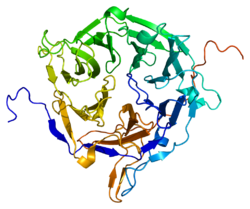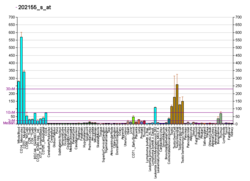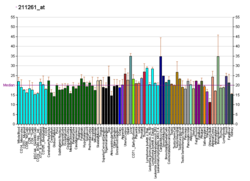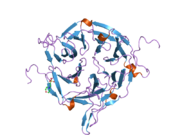Nucleoporin 214
Nucleoporin 214 (Nup2014) is a protein that in humans is encoded by the NUP214 gene.[5][6][7]
Function
[edit]The nuclear pore complex is a massive structure that extends across the nuclear envelope, forming a gateway that regulates the flow of macromolecules between the nucleus and the cytoplasm. Nucleoporins are the main components of the nuclear pore complex in eukaryotic cells. This gene is a member of the FG-repeat-containing nucleoporins. The protein encoded by this gene is localized to the cytoplasmic face of the nuclear pore complex where it is required for proper cell cycle progression and nucleocytoplasmic transport. The 3' portion of this gene forms a fusion gene with the DEK gene on chromosome 6 in a t(6,9) translocation associated with acute myeloid leukemia and myelodysplastic syndrome.[7]
Structure
[edit]The structure of the N-terminal domain of Nup214 reveals a sevenbladed beta-propeller fold followed by a 30-residue C-terminal extended peptide segment (CTE). The CTE folds back onto the beta propeller and binds to its bottom face.[8] The structure of the Nup214 NTD bound to the helicase Ddx19 in its ADP-bound state reveals the molecular basis for the interaction between the two proteins. A conserved residue of Ddx19 is shown to be crucial for complex formation in vitro and in vivo. Strikingly, the interaction surfaces exhibit strongly opposing surface potentials, with the helicase surface being positively and the Nup214 surface being negatively charged. Ddx19 is shown to bind RNA only in its ATP-bound state, and the binding of RNA and the Nup214 NTD is mutually exclusive.[9]
Interactions
[edit]NUP214 has been shown to interact with:
References
[edit]- ^ a b c GRCh38: Ensembl release 89: ENSG00000126883 – Ensembl, May 2017
- ^ a b c GRCm38: Ensembl release 89: ENSMUSG00000001855 – Ensembl, May 2017
- ^ "Human PubMed Reference:". National Center for Biotechnology Information, U.S. National Library of Medicine.
- ^ "Mouse PubMed Reference:". National Center for Biotechnology Information, U.S. National Library of Medicine.
- ^ Kraemer D, Wozniak RW, Blobel G, Radu A (Feb 1994). "The human CAN protein, a putative oncogene product associated with myeloid leukemogenesis, is a nuclear pore complex protein that faces the cytoplasm". Proceedings of the National Academy of Sciences of the United States of America. 91 (4): 1519–23. Bibcode:1994PNAS...91.1519K. doi:10.1073/pnas.91.4.1519. PMC 43191. PMID 8108440.
- ^ von Lindern M, Poustka A, Lerach H, Grosveld G (Aug 1990). "The (6;9) chromosome translocation, associated with a specific subtype of acute nonlymphocytic leukemia, leads to aberrant transcription of a target gene on 9q34". Molecular and Cellular Biology. 10 (8): 4016–26. doi:10.1128/mcb.10.8.4016. PMC 360912. PMID 2370860.
- ^ a b "Entrez Gene: NUP214 nucleoporin 214kDa".
- ^ Napetschnig J, Blobel G, Hoelz A (2007). "Crystal structure of the N-terminal domain of the human protooncogene Nup214/CAN". Proc. Natl. Acad. Sci. U.S.A. 104 (6): 1783–8. Bibcode:2007PNAS..104.1783N. doi:10.1073/pnas.0610828104. PMC 1794303. PMID 17264208.
- ^ a b Napetschnig J, Kassube SA, Debler EW, Wong RW, Blobel G, Hoelz A (2009). "Structural and functional analysis of the interaction between the nucleoporin Nup214 and the DEAD-box helicase Ddx19". Proc. Natl. Acad. Sci. U.S.A. 106 (9): 3089–94. Bibcode:2009PNAS..106.3089N. doi:10.1073/pnas.0813267106. PMC 2651337. PMID 19208808.
- ^ a b Herold A, Suyama M, Rodrigues JP, Braun IC, Kutay U, Carmo-Fonseca M, Bork P, Izaurralde E (Dec 2000). "TAP (NXF1) belongs to a multigene family of putative RNA export factors with a conserved modular architecture". Molecular and Cellular Biology. 20 (23): 8996–9008. doi:10.1128/mcb.20.23.8996-9008.2000. PMC 86553. PMID 11073998.
- ^ Schmitt I, Gerace L (Nov 2001). "In vitro analysis of nuclear transport mediated by the C-terminal shuttle domain of Tap". The Journal of Biological Chemistry. 276 (45): 42355–63. doi:10.1074/jbc.M103916200. PMID 11551912.
- ^ Carman JA, Nadler SG (Mar 2004). "Direct association of tristetraprolin with the nucleoporin CAN/Nup214". Biochemical and Biophysical Research Communications. 315 (2): 445–9. doi:10.1016/j.bbrc.2004.01.080. PMID 14766228.
Further reading
[edit]- Stoffler D, Fahrenkrog B, Aebi U (Jun 1999). "The nuclear pore complex: from molecular architecture to functional dynamics". Current Opinion in Cell Biology. 11 (3): 391–401. doi:10.1016/S0955-0674(99)80055-6. PMID 10395558.
- von Lindern M, Fornerod M, van Baal S, Jaegle M, de Wit T, Buijs A, Grosveld G (Apr 1992). "The translocation (6;9), associated with a specific subtype of acute myeloid leukemia, results in the fusion of two genes, dek and can, and the expression of a chimeric, leukemia-specific dek-can mRNA". Molecular and Cellular Biology. 12 (4): 1687–97. doi:10.1128/mcb.12.4.1687. PMC 369612. PMID 1549122.
- Nomura N, Miyajima N, Sazuka T, Tanaka A, Kawarabayasi Y, Sato S, Nagase T, Seki N, Ishikawa K, Tabata S (1995). "Prediction of the coding sequences of unidentified human genes. I. The coding sequences of 40 new genes (KIAA0001-KIAA0040) deduced by analysis of randomly sampled cDNA clones from human immature myeloid cell line KG-1". DNA Research. 1 (1): 27–35. doi:10.1093/dnares/1.1.27. PMID 7584026.
- Nomura N, Miyajima N, Sazuka T, Tanaka A, Kawarabayasi Y, Sato S, Nagase T, Seki N, Ishikawa K, Tabata S (1995). "Prediction of the coding sequences of unidentified human genes. I. The coding sequences of 40 new genes (KIAA0001-KIAA0040) deduced by analysis of randomly sampled cDNA clones from human immature myeloid cell line KG-1 (supplement)". DNA Research. 1 (1): 47–56. doi:10.1093/dnares/1.1.47. PMID 7584028.
- Pilz A, Woodward K, Povey S, Abbott C (Jan 1995). "Comparative mapping of 50 human chromosome 9 loci in the laboratory mouse". Genomics. 25 (1): 139–49. doi:10.1016/0888-7543(95)80119-7. PMID 7774911.
- Stutz F, Izaurralde E, Mattaj IW, Rosbash M (Dec 1996). "A role for nucleoporin FG repeat domains in export of human immunodeficiency virus type 1 Rev protein and RNA from the nucleus". Molecular and Cellular Biology. 16 (12): 7144–50. doi:10.1128/mcb.16.12.7144. PMC 231718. PMID 8943370.
- Fornerod M, van Deursen J, van Baal S, Reynolds A, Davis D, Murti KG, Fransen J, Grosveld G (Feb 1997). "The human homologue of yeast CRM1 is in a dynamic subcomplex with CAN/Nup214 and a novel nuclear pore component Nup88". The EMBO Journal. 16 (4): 807–16. doi:10.1093/emboj/16.4.807. PMC 1169681. PMID 9049309.
- Yaseen NR, Blobel G (Apr 1997). "Cloning and characterization of human karyopherin beta3". Proceedings of the National Academy of Sciences of the United States of America. 94 (9): 4451–6. Bibcode:1997PNAS...94.4451Y. doi:10.1073/pnas.94.9.4451. PMC 20743. PMID 9114010.
- Bonifaci N, Moroianu J, Radu A, Blobel G (May 1997). "Karyopherin beta2 mediates nuclear import of a mRNA binding protein". Proceedings of the National Academy of Sciences of the United States of America. 94 (10): 5055–60. Bibcode:1997PNAS...94.5055B. doi:10.1073/pnas.94.10.5055. PMC 24630. PMID 9144189.
- Bastos R, Ribas de Pouplana L, Enarson M, Bodoor K, Burke B (Jun 1997). "Nup84, a novel nucleoporin that is associated with CAN/Nup214 on the cytoplasmic face of the nuclear pore complex". The Journal of Cell Biology. 137 (5): 989–1000. doi:10.1083/jcb.137.5.989. PMC 2136229. PMID 9166401.
- Boer J, Bonten-Surtel J, Grosveld G (Mar 1998). "Overexpression of the nucleoporin CAN/NUP214 induces growth arrest, nucleocytoplasmic transport defects, and apoptosis". Molecular and Cellular Biology. 18 (3): 1236–47. doi:10.1128/mcb.18.3.1236. PMC 108836. PMID 9488438.
- Bogerd HP, Echarri A, Ross TM, Cullen BR (Nov 1998). "Inhibition of human immunodeficiency virus Rev and human T-cell leukemia virus Rex function, but not Mason-Pfizer monkey virus constitutive transport element activity, by a mutant human nucleoporin targeted to Crm1". Journal of Virology. 72 (11): 8627–35. doi:10.1128/JVI.72.11.8627-8635.1998. PMC 110274. PMID 9765402.
- Zolotukhin AS, Felber BK (Jan 1999). "Nucleoporins nup98 and nup214 participate in nuclear export of human immunodeficiency virus type 1 Rev". Journal of Virology. 73 (1): 120–7. doi:10.1128/JVI.73.1.120-127.1999. PMC 103815. PMID 9847314.
- Schmitt C, von Kobbe C, Bachi A, Panté N, Rodrigues JP, Boscheron C, Rigaut G, Wilm M, Séraphin B, Carmo-Fonseca M, Izaurralde E (Aug 1999). "Dbp5, a DEAD-box protein required for mRNA export, is recruited to the cytoplasmic fibrils of nuclear pore complex via a conserved interaction with CAN/Nup159p". The EMBO Journal. 18 (15): 4332–47. doi:10.1093/emboj/18.15.4332. PMC 1171509. PMID 10428971.
- Bachi A, Braun IC, Rodrigues JP, Panté N, Ribbeck K, von Kobbe C, Kutay U, Wilm M, Görlich D, Carmo-Fonseca M, Izaurralde E (Jan 2000). "The C-terminal domain of TAP interacts with the nuclear pore complex and promotes export of specific CTE-bearing RNA substrates". RNA. 6 (1): 136–58. doi:10.1017/S1355838200991994. PMC 1369901. PMID 10668806.
- Herold A, Suyama M, Rodrigues JP, Braun IC, Kutay U, Carmo-Fonseca M, Bork P, Izaurralde E (Dec 2000). "TAP (NXF1) belongs to a multigene family of putative RNA export factors with a conserved modular architecture". Molecular and Cellular Biology. 20 (23): 8996–9008. doi:10.1128/MCB.20.23.8996-9008.2000. PMC 86553. PMID 11073998.
- Hofmann W, Reichart B, Ewald A, Müller E, Schmitt I, Stauber RH, Lottspeich F, Jockusch BM, Scheer U, Hauber J, Dabauvalle MC (Mar 2001). "Cofactor requirements for nuclear export of Rev response element (RRE)- and constitutive transport element (CTE)-containing retroviral RNAs. An unexpected role for actin". The Journal of Cell Biology. 152 (5): 895–910. doi:10.1083/jcb.152.5.895. PMC 2198816. PMID 11238447.








